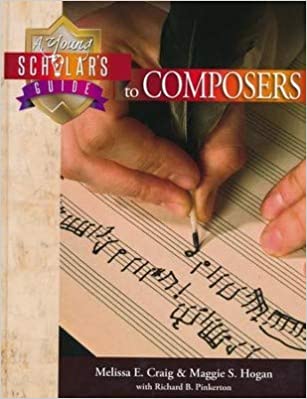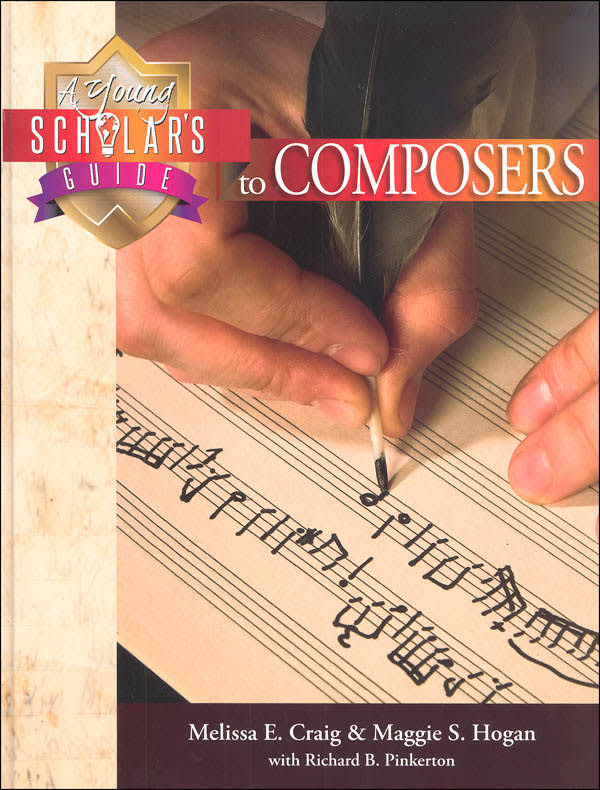A Young Scholar’s Guide to Composers is an introduction to the major eras of classical music and 26 famous composers who are representative of those eras, all from a Christian worldview. This multi-sensory course uses a combination of traditional learning, hands-on activities, and listening that should be appropriate for grades four through eight.
Study begins with a brief history of music, highlighting Gregorian Chant as the first music that was “written down.” Students next learn about the music of the Renaissance. All of this is background before students begin to learn about specific musical eras.
The first era introduced is the Baroque period. The typical lesson format begins at this point with an overview of the Baroque period. These introductory sessions have student note-taking pages so that students can easily learn highlights of each period.
Then we meet our first featured composer, Antonio Vivaldi. A biographical sketch of Vivaldi is intended to be read aloud. This and other biographical sketches should each take about 15 minutes to read. They are written on a level appropriate for children, with salacious biographical information omitted. Biographies discuss the spiritual beliefs (or lack of them) if that information is known. Biographies are each followed by a series of ten questions for students to answer based on the reading. Answer keys are at the back of the book.
A week should be allotted for the study of each composer with class time required only two days per week. The reading and note-taking or questions should be completed on the first day of class for that lesson. The second class session should be used for students to complete timeline and map activities and to create Composer Info-Cards.
Students should try to create a “folderbook”--a simplified lapbook made from only one file folder—for recording and storing important information. Instructions are provided, although they seem sketchy for anyone not already familiar with lapbooking or notebooking. I don’t think the folderbook is a critical component of the course, so don’t dismiss the course as an option if the folderbook seems overwhelming.
In addition to the scheduled activities, whenever it seems appropriate you can fill in with the Composers Bingo Game and coloring pages that are also included in the book.
Students should listen to one or more musical selections for the composer being studied at least three times per week during the week that the composer is featured. “Listening Suggestions” are found beginning on page 200 rather than directly in each lesson as you might expect. Suggestions include website URLs for musical performances plus additional teaching notes for composers as well as for historical periods. Be sure to check these out in advance of your lessons so you can ensure that weblinks are functioning when you need them. Students should review the name of the composer and one or more of his musical works at least a few times when you play them during the week.
Timeline pages are included toward the back of the book, with each covering a 50-year period beginning with the Baroque era. Students do not add images to the timeline. Instead, they color code with markers to show relationships between composers on the timeline (either as friends or as an influencer). Each composer’s life span is highlighted with the color of his musical era. At the bottom of the timeline are one or two dates of significant, non-musical events and a parallel timeline so students can readily make connections between musical events and events in the larger world. Samples of completed timelines in the back of the book demonstrate how this is to be done.
Map work is relatively simple. Three different maps are included, and each of these has portraits of selected composers surrounding the map. Students then draw a line connecting each composer to his appropriate country as he is studied, using color coding to identify the musical era. The color-coding system is found under directions for the timeline on p. 219. Using the same color-coding system for map work and the timeline helps reinforce learning.
Composer Info-Cards are used for reinforcement and review. Templates for these cards found in the book should be copied or mounted onto cardstock. One side of each card has space for the composer’s name, the musical period, and an image. Images are cut from other pages in the book and mounted on the cards. For the reverse side of each card, you need to make sure you’ve copied the correct one of three templates since each includes a small map on which students will color in the country of origin for the composer. In addition to the map, there are lines for students to enter other information such as years he lived, famous compositions, and evidence as to whether or not the composer was a Christian. While students can simply use the completed Composer Info-Cards like flashcards, it is more fun to play a game with them as suggested in the book.
While all of the teacher and student material I have described is contained within this book, you do need to locate recordings of the music by each of the different composers that you will be studying. As I mentioned previously, these are readily available from online sources for free at the listed URLs. However, you might find it worth investing in some high-quality recordings of at least some of the composers’ works.
Parents or teachers need to become familiar with this course book and the locations of critical course components in advance. I’ve noted a few such things in this review when the location of particular information is not readily apparent. It would have been helpful to have more links to these pages noted directly within each lesson since it’s easy to miss some of the components if you only look at the lessons themselves.
The combination of hands-on learning with more traditional learning methods should make this course interesting to children with different learning styles. Adding or skipping the coloring pages and the folderbook also helps you adapt to the needs of each student.
A Young Scholar’s Guide to Composers is available either in print or as a digital download.











